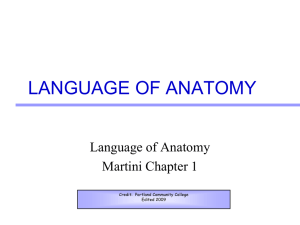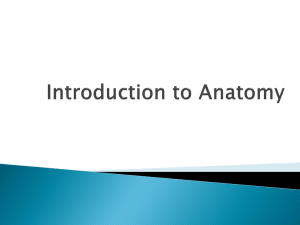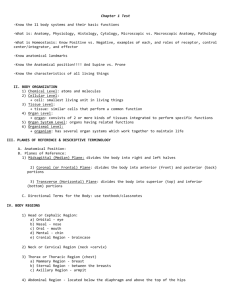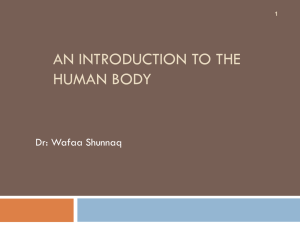Lect1
advertisement
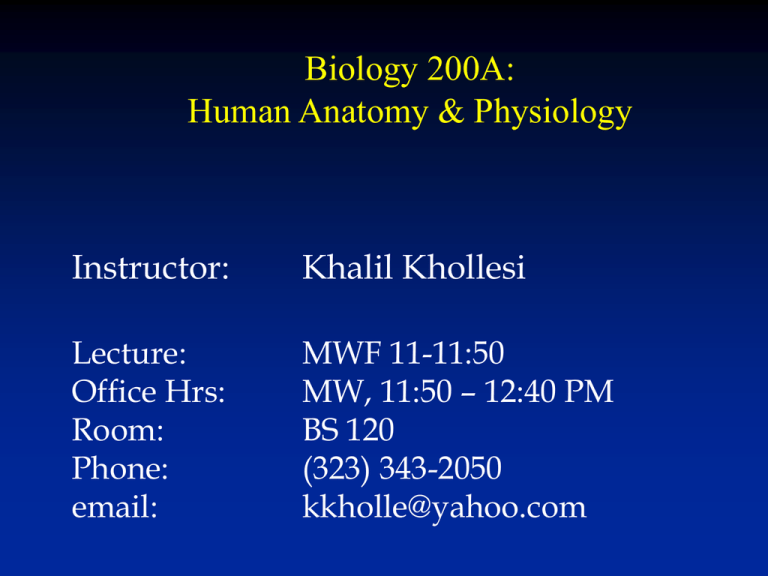
Biology 200A: Human Anatomy & Physiology Instructor: Khalil Khollesi Lecture: Office Hrs: Room: Phone: email: MWF 11-11:50 MW, 11:50 – 12:40 PM BS 120 (323) 343-2050 kkholle@yahoo.com Course Description • A two-quarter course, with required lab section • Designed for non-science majors (not for pre-med students) • This quarter: anatomical terminology, structure & function of cells & tissues, basic biochemical & metabolic pathways, and the integumentary, skeletal, muscular, digestive, and urinary systems. • Required textbook: Anatomy and Physiology, fifth edition, R. Seeley, T.D. Stephens and P. Tate • Grading on curve with plus/minus system Course Objectives The objectives of the course are: • to gain a detailed knowledge of the structure and function of the human body; • to appreciate the relationships between structure and function; and • to understand how various cells, tissues, organs and organ systems work together to maintain body function. Lectures for Download and Printing • There is a web page available for the course containing the Powerpoint lecture slides. A short and long version of the lectures are posted with the short version containing only text. • You can find the Bio 200A Home Page at: http://instructional1.calstatela.edu/kkholle • Access the WWW through the Netscape software program available on computers throughout campus. • To obtain an NIS computer access account, go to the Academic Technology Support Office, King Hall D149 Grading • You will receive a single grade, combining scores in lecture and lab portions of the course. • Point distribution is as follows: • Two written midterm exams: 160 pts total • One written final exam: 140 pts • Three (of four) lab quizzes 75 pts total • Written lab report 25 pts • Two lab practical exams 200 pts total • Lecture quizzes 30 pts Total points……………..…….….…630 • Missed exams must have a valid written excuse. No makeup exams! You must take the final to receive a grade in the course. • Grading is based on the class curve, EXCEPT THAT YOU MUST have at least 315 points to pass the course. Lecture Quizzes • Come to lecture. Bring paper, pencil/pen, ID. • Take a graded “minute quiz” • Earn up to 2 points per lecture quiz (most lectures) Enrollment • Enrollment is handled in lab sections only. • You must be enrolled in a lab to enroll in the course. • You must attend and take exams in the lab you are enrolled in! • Open Enrollment students: enroll after second week of the quarter, if space permits. What are characteristics of living things? • Growth: an increase in size through increase in the number or size of their cells • Reproduction: the ability to produce offspring • Movement: either internal or through the environment • Responsiveness: the ability to sense changes in the environment and react accordingly • Metabolism: the construction or break-down of substances involved in energy production Anatomy: The Study of Structure • Microscopic Anatomy (histology and cytology): The study of tissues and cells. • Gross Anatomy: The study of structures visible to the unaided eye. • Approach: Systemic vs. Regional Systemic: by system Regional: by area Levels of Organization Subcellular: Molecular (atoms, molecules), organelles Cellular Tissue Organ System/Organism Physiology: The Study of Function - Nervous System - Muscular System - Skeletal System - Respiratory System - Cardiovascular System - Endocrine System - Integumentary System - Immune, digestive, and reproductive systems Basic Concepts in Physiology Homeostasis: The maintenance of constant environment in the body (temperature, chemical composition). The loss of homeostasis leads to disease and/or death! Feedback Mechanisms: Maintain homeostasis through detection of environmental conditions and appropriate adjustments. Anatomy: The Basic Body Plan • The body is a three dimensional, bilaterally symmetrical object. • The body is organized as a trunk with hollow tube inside (GI tract), and attached appendages (arms, legs, head). Anatomical Position Anatomical terms are used in reference to the body in anatomical position: - Body is erect, with feet together - Head and toes are pointed forward. -Arms are at side, with palms forward. Directional Terms -superior vs. inferior (Cephalic vs. caudal) -anterior vs. posterior (ventral vs. dorsal) -medial vs. lateral -proximal vs. distal -superficial vs. deep Terminology of three dimensional planes - sagittal sections: separate left from right - frontal/coronal sections: separate anterior from posterior - transverse/horizontal sections: separate superior from inferior Regions of the Body Appendicular Regions: arm, forearm, wrist, hand, thigh, leg, ankle, foot Axial Regions: head, neck, thorax, abdomen, pelvis Terminology of Body Cavities Dorsal Cavity: Brain, spinal cord Ventral Cavity: - thoracic - pleural cavities (lungs) - pericardial (heart) - abdomino-pelvic - abdominal (GI tract) - pelvic (reproductive organs) MINUTE QUIZ! • The stomach is located in the a) thoracic cavity b) dorsal cavity Correct! c) abdominal cavity d) pelvic cavity Terminology of Linings of Ventral Cavity • The thoracic and abdominal cavities and their contents are lined with thin serous membranes, which secrete fluid for lubrication. • The serous membranes covering the walls of the cavities are called parietal serous membranes. • Serous membranes covering the organs are called visceral serous membranes. Terminology of Linings of Ventral Cavity • The serous lining of the pleural cavity is called the pleural membrane, or pleura. • The serous lining of the pericardial cavity is called the pericardial membrane, or pericardium. • The serous lining of the abdominal cavity is called the peritoneal membrane, or peritoneum. Remember that for each of these, there is a parietal part and a visceral part. Next Lecture..... The Cell: Structure, Function and Replication
